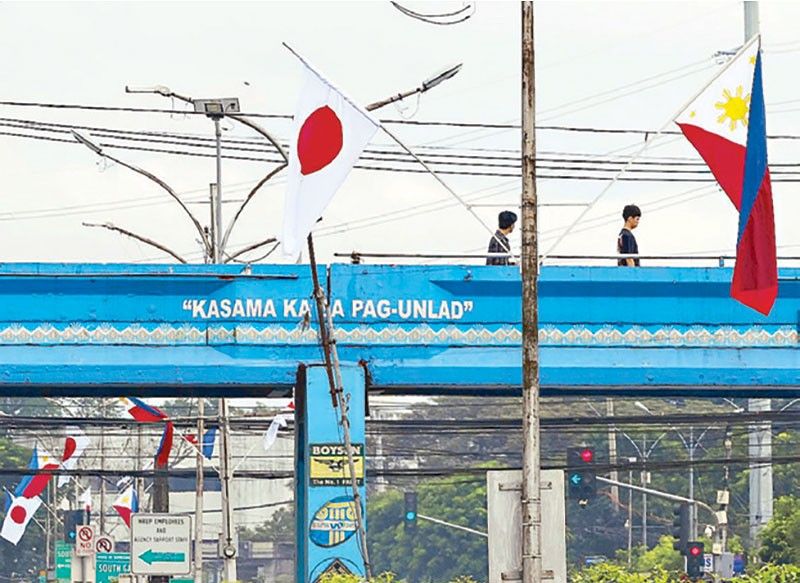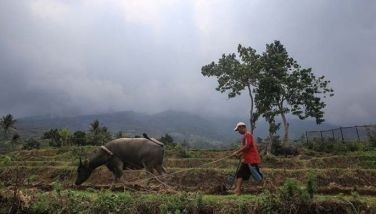West Philippine Sea on Marcos agenda with visiting Japan PM

MANILA, Philippines — China’s aggressive actions in the West Philippine Sea is expected to highlight President Marcos’ discussions today with visiting Japanese Prime Minister Fumio Kishida, Malacañang said.
Kishida’s official visit, which ends tomorrow, comes in the wake of incidents wherein China Coast Guard ships harassed Philippine Navy vessels on patrol near Panatag (Scarborough) Shoal, and attempted to stop Philippine resupply missions for troops on BRP Sierra Madre in Ayungin (Second Thomas) Shoal.
Tokyo’s ties with Manila were elevated to a strategic partnership in 2011.
“Among the specific issues to be discussed are the West Philippine Sea, trade and investment, and Japan’s official development assistance (ODA),” the Department of Foreign Affairs said in a statement released by the Presidential Communications Office (PCO) yesterday.
“They will also exchange views on major regional, international and United Nations issues affecting the region and the world,” the PCO added.
China has been showing more aggressiveness in asserting its sweeping claims in the South China Sea, despite getting rebuffed by an international arbitral court based in The Hague, which invalidated Beijing’s claim and reaffirmed the Philippines’ maritime entitlements in a ruling in July 2016.
The latest incident of Chinese harassment took place on Oct. 22 when CCG and maritime militia vessels hit Philippine Coast Guard ship BRP Cabra and Unaiza May 2, while in the process of stopping the Filipino vessels from reaching the Sierra Madre to unload provisions.
The Department of National Defense described the incident as “a serious escalation of the illegal activities conducted by the Chinese government in the West Philippine Sea,” noting that it happened within the Philippines’ 200-mile exclusive economic zone.
Last Monday, the Chinese military claimed that a Philippine frigate “trespassed” into the waters near Panatag Shoal, a traditional fishing ground off Zambales. National Security Adviser Eduardo Año said the CCG shadowed the movement of the BRP Yap then on patrol.
Like the Philippines, Japan also has a territorial dispute with China over the Senkaku Islands in the East China Sea.
Last June, the national security advisers of the Philippines, Japan and the US met in Tokyo and reaffirmed the importance of enhancing trilateral cooperation and response capabilities to maintain peace and stability in the Indo-Pacific region. They also agreed that a free and open maritime order, characterized by freedom of navigation, and a free, fair, and equitable economic order are essential in the Indo-Pacific, “especially given unilateral attempts to change the status quo by force or coercion.”
The officials also talked about opportunities for combined maritime activities including multilateral joint naval exercises in Indo-Pacific waters.
Last February, Marcos made an official visit to Japan, where he met with Kishida, as well as with Emperor Naruhito and Empress Masako. The President sealed $13 billion worth of agreements during the trip, according to the PCO.
Japan is one of the Philippines’ largest trade, investment and development partners and its largest ODA provider of loan and grant commitments. Its $12.92-billion ODA loan to the Philippines represents approximately 40.5 percent of the country’s total ODA portfolio.
Fallback
Meanwhile, Surigao del Sur Rep. Johnny Pimentel said it may not be too late yet for the Marcos administration to consider Japan as a “fallback” sponsor for key projects following the decision of economic managers to discontinue Chinese funding, due largely to Beijing’s provocations in the West Philippine Sea.
Pimentel said there is still hope for stalled infrastructure projects to push through despite the absence of funding from China, as the Philippines may turn to Japan for help.
“Our sense is, Japan is our best recourse, considering that JICA (Japan International Cooperation Agency) is already helping our Department of Transportation in modeling our 30-year railways master plan for Metro Manila, Central Luzon, and the Calabarzon,” he said.
Pimentel’s remarks came ahead of Prime Minister Kishida’s visit to the Philippines today until tomorrow.
“JICA is already providing us the extremely low-interest official development assistance loans for the Metro Manila Subway and other rail projects in Luzon. We might as well ask them to double down and grant us the concessional loan for the MRP,” he said.
“We absolutely need the MRP (Mindanao Railways Project) to accelerate the transfer of people and goods, and drive Mindanao’s economic and social development,” Pimentel, an assistant minority leader, said.
As originally designed, the MRP stretches for 1,544 kilometers covering the cities of General Santos, Cagayan de Oro, Iligan, Cotabato, Zamboanga, Butuan, Surigao and Malaybalay.
Rep. Brian Raymund Yamsuan said that even with China out of the picture, President Marcos is determined to see the “Bicol Express” project completed.
“President Marcos is not only bent on reviving and modernizing the Bicol Express as he had promised Bicolanos. He is also making sure that affected residents would not be neglected by ensuring that they get to resettle in livable communities,” Yamsuan said.
Marcos recently led the groundbreaking for resettlement sites for residents of Laguna and Quezon who were likely to be affected by the construction of the project.
“This is the strongest indicator that the project will push through,” the Bicol Saro party-list representative said.
According to Yamsuan, removing Beijing as financier may prove to be even more beneficial to the country, especially now that the country would be able to tap other funding sources offering more cost-effective financing packages.
The first stage of the project to revive the Bicol Express line, known as the South Long Haul Project, will start from Banlic town in Laguna to Daraga in Albay. An extension of the line to Sorsogon is also being eyed.
Connecting Laguna to Bicol, the first package of the 368-kilometer Bicol Express project is expected to reduce travel time between the two points from the current 14-18 hours to six hours, using regular commuter trains, and 4.5 hours, using the line’s express trains.
The project would be linked to the North-South Commuter Railway System, originally envisioned to link the provinces of Bulacan and Pampanga in the north, to Metro Manila and Laguna in the South.
- Latest
- Trending
































